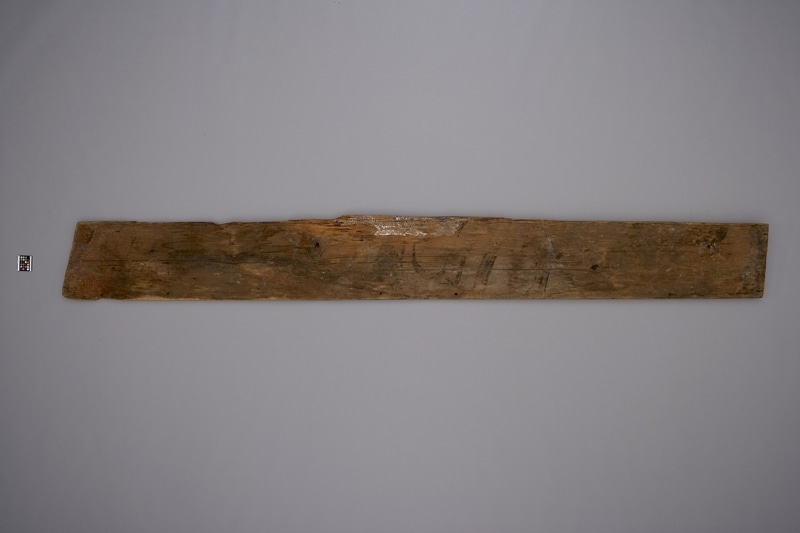House Screen Board Item Number: Nb7.241 a from the MOA: University of British Columbia

Description
A long rectangular cedar plank with faded Northwest Coast designs imprinted in the surface of the wood near the centre in a diagonal fashion. Orange coloured patch near centre of the wood at one side. Black coloured designs are more visible near centre and the bottom of the piece. Long indentation down the centre of the top of the board. Four prominent knots in wood, two near the top and two near the bottom. Small horizontal groove at the top of the board with cedar cording embedded in the middle. Two rectangular notches in wood at bottom of board. Top edge of board is cut on a slant. There are evenly spaced rectangular carved sections are located on the edge of the piece to one side. Across the top and bottom of the board there is a long rectangular cut.
History Of Use
The largest paintings created by Northwest Coast artists of the 18th and 19th centuries functioned as house-front and interior screens. Made of wide, hand-split cedar planks, such screens displayed the family crests of their high-ranking owners. The paintings usually depicted animal or spirit beings, and symbolized pivotal events in the lives of the ancestors. Few of these monumental paintings still remained by 1900, as Indigenous families replaced their traditional extended-family houses with Victorian-style, single-family dwellings.
Narrative
These planks are the oldest existing example of such house-front paintings. They constitute the only evidence of a painted façade that would have measured 5.5 metres (18 feet) high and 15 metres (50 feet) across. The boards were collected in Lax Kw’alaams, a village on the northern coast of BC. The boards were likely brought to Lax Kw’alaams from one of the older villages close to the mouth of the Skeena River. In 1831 Fort Nass was built at the mouth of the Nass River; in 1834 the fort was moved and renamed Fort Simpson, at the Tsimshian summer village of Lax Kw’alaams. The first Hudson's Bay Company (HBC) factor married the daughter of Gispaxlo'ots Chief Legaic, as part of the diplomacy which established the new fort and trading post on their territory. In the mid 1800s, Ts’msyen chiefs from nine tribes built their houses near the trading post. (In 1880 the community was renamed Port Simpson; in 1986 the name was officially changed back to Lax Kw'alaams, "place of wild roses".)
Specific Techniques
Only paints made of hematite (red) and magnetite (black) were used by the artist(s) who created the images on these boards; there are no traces of the trade paints that were adopted as soon as they became available from fur traders. Now, little of the original painted composition remains. However, when a bright light is raked across the surface, traces of an extraordinary image are revealed. Components of the composition that were originally painted emerge as slightly raised forms, as though they were carved in low relief – yet they were not carved, but simply protected by the paint from the effects of wind-driven sand and salt. The areas left unpainted, by contrast, were eroded over time. The board would have been split from a red cedar tree, with the front surface knifed smooth to create a surface for the fine painted lines. Along the edge are holes through which cedar withe was threaded and sewn to other planks. After the house boards entered the museum collection, it was discovered that light raked across the surface of the boards, combined with high-contrast photography, revealed an elegant painting at least two hundred years old.
Item History
- Made in British Columbia, Canada between 1800 and 1840
- Collected in Port Simpson, British Columbia, Canada and Lax Kw'alaams, British Columbia, Canada between 1893 and 1934
- Owned by George H. Raley before November 1948
- Received from H. R. MacMillan (Funding source) and George H. Raley (Seller) during November 1948
What
- Name
- House Screen Board
- Identification Number
- Nb7.241 a
- Type of Item
- board
- Material
- cedar wood, paint and metal
- Overall
- height 366.0 cm, width 43.0 cm, depth 5.3 cm
Who
- Culture
- Tsimshian
- Previous Owner
- George H. Raley
- Received from
- H. R. MacMillan (Funding source) and George H. Raley (Seller)
Where
- Holding Institution
- MOA: University of British Columbia
- Made in
- British Columbia, Canada
- Collected in
- Port Simpson, British Columbia, Canada and Lax Kw'alaams, British Columbia, Canada
When
- Creation Date
- between 1800 and 1840
- Collection Date
- between 1893 and 1934
- Ownership Date
- before November 1948
- Acquisition Date
- during November 1948
Other
- Condition
- fair
- Accession Number
- 1960/0495 a-b